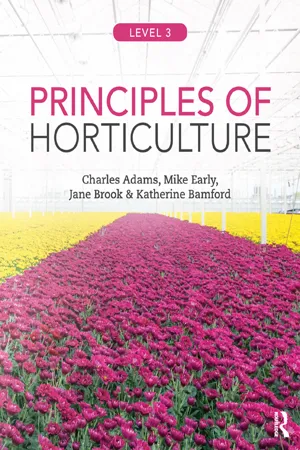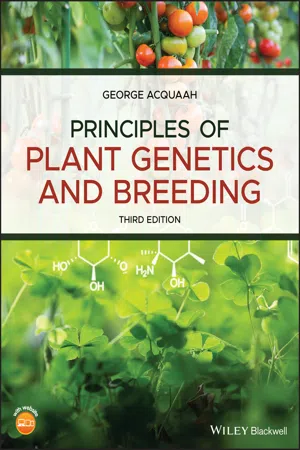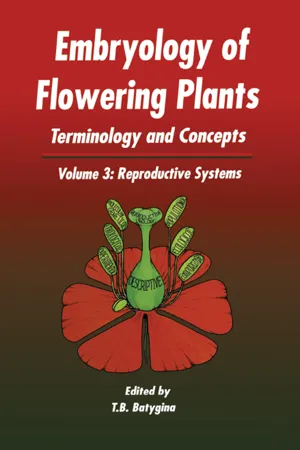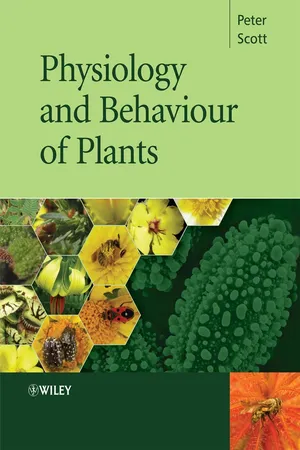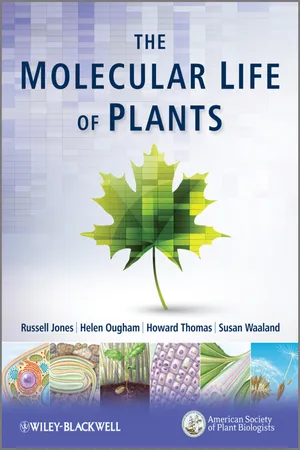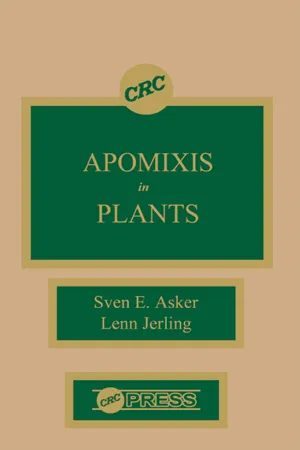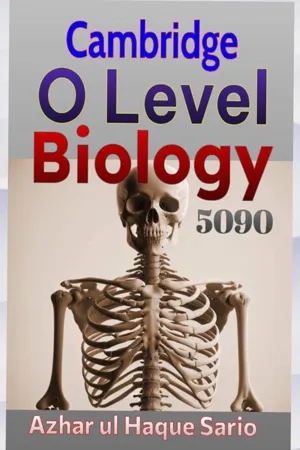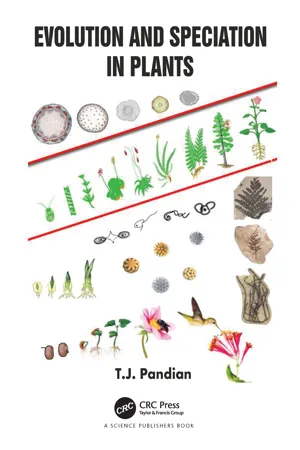Biological Sciences
Sexual Reproduction in Plants
Sexual reproduction in plants involves the fusion of male and female gametes to produce offspring with genetic variation. It typically involves the formation of flowers, pollination by wind, insects, or other animals, and the development of seeds. This process allows for genetic diversity and adaptation to changing environments.
Written by Perlego with AI-assistance
Related key terms
10 Key excerpts on "Sexual Reproduction in Plants"
- eBook - ePub
- Charles Adams, Mike Early, Jane Brook, Katherine Bamford(Authors)
- 2015(Publication Date)
- Routledge(Publisher)
4CHAPTERLevel 3Plant reproduction
Figure 4.1 Bees and other pollinating insects are attracted to large, colourful fl owers. The Iris shown has blue fl owers, a colour attractive to bumble bees, and tepals which can support the bee’s weight with nectar guides directing the bees towards nectaries at their baseThis chapter includes the following topics:• Inflorescence types• Pollination syndromes• Cross- and self-pollination mechanisms• The relevance of cross-and self-pollination to horticulture• Fertilization• Seed structure – endospermic and non-endospermic seeds• Seed dormancy• Seed quality – testing and treatments• Seed provenance and conservation• Fruit development, structure and classification• Asexual reproduction and vegetative propagationPrinciples of Horticulture. 978-0-415-85909-7 © C.R. Adams, M.P. Early, J.E. Brook and K.M. Bamford. Published by Taylor & Francis. All rights reserved. Figure 4.2 Inflorescences which are designed to maximize pollen dispersal and capture: (a) in a Betula (birch) left, female catkins; right, male catkins; (b) in grassesReproduction is the process by which new individuals are formed and hence the species is perpetuated. In plants this can be asexual, by means of a range of vegetative structures or it can be sexual resulting in seeds. Sexual reproduction has two key advantages for the plant. It gives rise to variation in a plant's offspring, enabling it to withstand environmental pressures and it also provides the means by which plants can colonize new areas, through dispersal of seeds, often enclosed within a fruit. Although plants produced from seed are genetically variable and will not be uniform in their growth and other characteristics such as size, flower colour etc., this variation can be controlled by skilled plant breeders (see F1 hybrids p. 47 - eBook - ePub
- George Acquaah(Author)
- 2020(Publication Date)
- Wiley-Blackwell(Publisher)
gametes. Gametes are products of meiosis and, consequently, seeds are genetically variable. Asexual or vegetative reproduction mode entails the use of any vegetative part of the plant for propagation. Some plants produce modified parts such as creeping stems (stolons or rhizomes), bulbs, or corms, which are used for their propagation. Asexual reproduction is also applied to the condition whereby seed is produced without fusion of gametes (called apomixis). It should be pointed out that some plants could be reproduced by either the sexual or asexual mode. However, for either ease of propagation or for product quality, one mode of reproduction, often the vegetative mode, is preferred. Such is the case in flowering species such as potato (propagated by tubers or stem cuttings) and the sugarcane (propagated by stem cuttings).5.4 Sexual reproduction
Sexual reproduction increases genetic diversity through the involvement of meiosis. Flowering plants dominate the terrestrial species. Whereas flowers are required, flowering plants may reproduce sexually or asexually.5.4.1 Sexual lifecycle of a plant (alternation of generation)
The normal sexual lifecycle of a flowering plant may be simply described as consisting of events from first establishment to death (from seed to seed in seed‐bearing species). A flowering plant goes through two basic growth phases – vegetative and reproductive, the former preceding the latter. In the vegetative phase, the plant produces vegetative growth only (stem, branches, leaves, etc., as applicable). In the reproductive phase, flowers are produced. In some species, exposure to a certain environmental factor (e.g. temperature, photoperiod) is required to switch from vegetative to reproductive phase. The duration between phases varies among species and can be manipulated by modifying the growing environment.In order for sexual reproduction to occur, two processes must occur in sexually reproducing species. The first process, meiosis, reduces the chromosome number of the diploid (2n) cell to the haploid (n) number. The second process, fertilization, unites the nuclei of two gametes, each with the haploid number of chromosomes, to form a diploid. In most plants, these processes divide the lifecycle of the plant into two distinct phases or generations, between which the plant alternates (called alternation of generation) (Figure 5.1 ). The first phase or generation, called the gametophyte generation, begins with a haploid spore produced by meiosis. Cells derived from the gametophyte by mitosis are haploid. The multicellular gametophyte produces gametes by mitosis. The sexual reproductive process unites the gametes to produce a zygote that begins the diploid sporophyte generation - eBook - ePub
- Rene Fester Kratz(Author)
- 2011(Publication Date)
- For Dummies(Publisher)
along the edges. These plantlets can drop to the ground, produce roots, and grow into new individuals. Plants called liverworts make tiny little cups called gemmae on the surfaces of their leaf-like bodies. When rain splashes into the cups, clumps of cells break off and scatter, forming new plants wherever they land.Flowers: Although flowers usually mean sexual reproduction, some plants, such as citrus trees, produce seeds asexually by a process called agamospermys . During agamospermy, a cell from the parent plant develops into a seed containing an embryo that is a genetic copy of the parent.Fragmentation, the process where a plant part breaks off and develops into a new individual, occurs with stems, roots, and even leaves.Sexual reproductionAlthough asexual reproduction is very common in plants, most plants can also mix it up a little by combining their genetic information with another plant to produce offspring that have unique combinations of genetic information.Most plants can do asexual reproduction and sexual reproduction, where an egg from one plant combines with sperm from another plant to produce offspring that have new combinations of traits. Tulips, for example, reproduce asexually through tulip bulbs, but also reproduce sexually by making flowers, fruits, and seeds.Comparing reproductive styles Both asexual reproduction and sexual reproduction have their advantages:The most obvious participants in sexual reproduction are the flowering plants — their showy flowers are basically advertising that they’re looking for a mate — but more subtle plant sex is happening around you all the time. All the cone-bearing plants, such as pine, spruce, and fir, do sexual reproduction, as do flowering trees like maple, oak, and willow. Sex is even going on among the grass and moss under your feet!Asexual reproduction rapidly produces copies of a successful organism.• Advantage:If the traits of the parent plant are working well in a particular environment, then asexual reproduction will produce more successful organisms without the hassle of finding a mate. In other words, if it ain’t broke, don’t fix it. - eBook - ePub
Embryology of Flowering Plants: Terminology and Concepts, Vol. 3
Reproductive Systems
- T B Batygina, T B Batygina(Authors)
- 2019(Publication Date)
- CRC Press(Publisher)
et al., 1978).In literature the notions “propagation”, “reproduction” and “renewal” are often mixed, and occasionally the latter is understood even as “the sexual process”. In this matter first Darlington (1958) and later John and Lewis (1975) and other authors designated “sexual reproduction” (but not sexual process —T.B.) as a process comprising meiosis and fertilization. Dick (1987) also used the term “sexual reproduction” to explain sexual process (fusion of nuclei, produced by different meiosis (allo- and autogamy)). Unlike Mogie (1986), he referred to the fusion of nuclei of single meiosis as “pseudosexual reproduction”. In this case the author practically also mixes different notions. It is likely correct to speak about pseudosexual process. Sladkov (1986) replaces the notion “reproduction” with the term “generative propagation” and connects it with the change of nuclear phases. In addition he includes in it sexual propagation and asexual propagation (by spores). All this testifies how difficult and debatable this problem is and how much it complicates the understanding of all phenomena observed in plant propagation. It is from the context that we can understand in what sense the authors use the term “reproduction”, to mean either reproduction itself or propagation.One of the greatest Italian scientists, Battaglia (1963), somewhat cleared up this most complicated biological question. It is known that organisms are able to arise in the same phase (in the ontogenetic sense, i.e., sporophyte from sporophyte) or in the antithetic phase (i.e., sporophyte from gametophyte). From this perspective, reproduction can be accordingly divided into homophasic and heterophasic. Battaglia suggests we use two different terms: “reproduction” (for heterophasic increase in number) and “multiplication - eBook - ePub
- Peter Scott(Author)
- 2013(Publication Date)
- Wiley-Interscience(Publisher)
Longevity . Plants may, in many instances, be long-suffering and long-lasting, but if the great extinctions of the past teach us anything, it is that nothing lasts forever. No matter how old an individual plant is, one day conditions will change to make survival impossible. Plants need some means of surviving such adverse conditions, which may be local or temporary, and reproduction can offer a solution to this. Clonal plants may move away from the point of origin of the mother plant and therefore widen the spread of the plant, thereby escaping a particular stress. In addition, seeds offer even greater opportunities to disperse genetic material well away from the parent plant and also provide a structure that can remain dormant over prolonged periods. This permits a plant to survive temporary changes in conditions. Clones or seeds also produce new individuals which are free from fungal infections or damage present in the parent plant.3. Genetic variation . Finally, reproduction offers opportunities for genetic variation, which is essential in a changing habitat. Asexual reproduction offers little opportunity for genetic variation but the potential from sexual reproduction is immense.In this chapter we will look in greater detail at how plants reproduce and the merits and limitations of the different methods.Asexual reproduction
Many plant species use asexual reproduction as a means of propagation. Asexual reproduction has several advantages and disadvantages (Figure 9.1 ). This form of reproduction produces individuals that are genetically identical and does not support much scope for phenotypic variation. This can lead to plants being vulnerable to changes in the habitat. In addition, offspring are generated close to the parent plant, so parent and offspring often have to compete for nutrients and light. However, asexually produced plants usually attain adulthood in advance of seedlings of the same parent and hence rapidly out-compete neighbouring plants reliant on seeds. Under many conditions, asexual reproduction is more successful than sexual reproduction for plants and a large number of species use this as their sole means of reproduction.Figure 9.1 ASexual Reproduction in Plants. Plants possess a range of different means of asexual reproduction. (A) Apomixis: using this method, the flowers spontaneously produce seeds without the need for any fertilization. The actual source of the embryo can come from the egg cell or the cells surrounding it. (B) A hyacinth bulb (Hyacinthus hybrid); bulbs frequently produce bulbils (small offset bulbs) at the base of the bulb. (C) A gladiolus corm (Gladiolus hybrid); corms frequently produce small offset corms at the base of the stem. (D) Strawberry plant (Fraxinus hybrid), forming runners, modified stems that form new plants. (E) Black poplar (Populus nigra - eBook - ePub
- Russell L. Jones, Helen Ougham, Howard Thomas, Susan Waaland(Authors)
- 2012(Publication Date)
- Wiley-Blackwell(Publisher)
Part VI RenewalPassage contains an image Chapter 16 Flowering and sexual reproduction
16.1 Introduction to Flowering
Charles Darwin called the sudden appearance and rapid spread of flowering plants during evolution an ‘abominable mystery’. No less mysterious is why the sexual mode of biological reproduction should have arisen in the first place, particularly in plants, where the property of cellular totipotency allows efficient asexual propagation. But sexual reproduction by means of flowers clearly confers fitness benefits and competitive advantages: the first flowering plants emerged 125 million years ago and within the geologically brief timespan of 60 million years angiosperms had established themselves as the dominant form of vegetation, accounting for more than 80% of the species in most ecosystems.As with the principles determining body plan and morphogenesis (see Chapter 12), the reproductive strategies of seed plants and higher animals differ in fundamental aspects (Figure 16.1 ). During early embryogenesis in animals, somatic cells (destined to give rise to all body tissues other than those producing eggs and sperm) are differentiated from germ line cells (committed to becoming the gametes) (Figure 16.1 A). The decision about whether a given cell takes the somatic or germ line route to maturity depends on intrinsic factors, such as cytoplasmic polarity, and on signaling from neighboring cells. Normally, once a cell is committed to the germ line or soma, neither it nor the cells derived from it can divert into the alternative developmental fate. As a consequence, the animal reproductive system is not exposed to the developmental signals that subsequently induce formation of the major somatic tissues and organs, and mutations can be inherited only if they affect germ line cells.Figure 16.1 - eBook - ePub
- Sven Asker, Lenn Jerling(Authors)
- 2017(Publication Date)
- CRC Press(Publisher)
This scenario fits with the theory of POL where the basic factor is to survive (DNA repair), and second, to produce new automata which are capable of functioning (as proven by the parent). The genetic variation (fertilization in combination with meiosis) is a secondarily derived tactic to meet environmental fluctuations.2. Clones vs. Clades — Arguments for Sexual Reproduction Based on Speciation RatesA historical explanation for the prevalence of sexual reproduction emphasizes the role of the rate of speciation.38 The view that major evolutionary changes occur at speciation events and not during the course of intraspecific gradual evolution is held within the theory of punctuated equilibria.12 The function of sexual reproduction is not to increase the evolutionary rate within a species and lower the rate of extinction, but rather the long-term advantage lies in higher rates of diversification.38Stebbins41 claimed that asexual groups tend to become extinct rapidly, not because of their inability to evolve, but because of a poor ability to diversify. Asexual clones may even tend to survive longer than sexuals since clones may diversify more rapidly intraspecifically in an ecological and genetic sense because they are not constrained by interbreeding.38 Large-scale evolution is, according to Stanley,39 decoupled from microevolution and large-scale trends are determined by the ability to speciate. Species selection favors those which survive for long periods and speciate at a high rate. This view falls within the framework of POL, but not directly within neo-Darwinism, since it emphasizes the persistence aspect of lineages and selection above the species level. The reason for sex is thus that extinction rates can be balanced by high speciation rates.393. Sex as a Consequence of the Level of Organization - eBook - ePub
- Azhar ul Haque Sario, Azhar ul Haque Sario(Authors)
- 2023(Publication Date)
- tredition(Publisher)
Genetic Potluck Party: Cross-pollination is like plants sharing their genetic gifts at a big party. Pollen from one plant fertilizes another, leading to babies with a mix of features. This genetic diversity gives these plants a bigger set of traits to work with, like having a full wardrobe for all seasons.Ready for Surprises: Plants that cross-pollinate are better at dealing with unexpected changes. They have a wide variety of genetic traits, so there's a better chance some of them will cope with new diseases or environmental shifts. It's like having a tool for every job that might come up.Relying on Pollinator Buddies: These plants depend on friends like bees and birds to move pollen. They have a special relationship with these pollinators, but if their pollinator pals are in trouble, so are they. It's like needing a friend to lend you a tool – if they don't show up, you're stuck.In Summary:Both self-pollination and cross-pollination have their ups and downs. Self-pollination offers simplicity and independence but limits genetic variety and adaptability. Cross-pollination brings a rich mix of genes, which is great for adapting to new situations, but it also means these plants need pollinators to thrive. How a plant reproduces is a big deal, influencing how it deals with life's challenges and opportunities.In the intricate journey of plant reproduction, the growth of the pollen tube and its subsequent entry into the ovule, leading to fertilization, is a fascinating process. This natural event is key to the development of seeds in flowering plants. Let's explore this process in simple, yet detailed terms.1. The Pollen Grain's Arrival: The story begins when a pollen grain, the male reproductive unit of a flower, lands on the stigma of a pistil – the female part of another flower. The stigma is often sticky, helping the pollen grain to adhere.2. Germination of the Pollen Grain: Once securely positioned, the pollen grain undergoes a transformation. It germinates, which means it starts to grow. This growth is fueled by the nutrients present in the pollen.3. Formation of the Pollen Tube: The germinated pollen grain forms a thin, tubular structure called the pollen tube. This tube is like a microscopic tunnel, and it has a crucial mission: to transport the male genetic material to the female ovule. - eBook - ePub
- T.J. Pandian(Author)
- 2022(Publication Date)
- CRC Press(Publisher)
Part C Gametogenesis and FertilizationGametogenesis is the process through which gametes are produced. Unlike in animals, gametes are generated through mitosis in haplontic algae and bryophytes. However, they are produced through meiosis and also at the ratio of one egg per oogonium but four sperms or pollens per spermatogonium in all pteridophytes, as in animals. Angiosperms are characterized by double fertilization. In lower plants including bryophytes and tracheophytes, oogamous fertilization is achieved by motile spermatozoa swimming through anaqueous medium. But it is achieved symbiotically engaging pollinating animals in most flowering plants. Interestingly, pollination involves coevolution between pollinators and plants. Spores and seeds of plants are dispersed by water, and wind as well as symbiotically engaging animals.Passage contains an image
10 Oogenesis and Spermatogenesis
Introduction
Regarding gametogenesis, animals and plants present a contrasting picture. Firstly, gametogenesis in animals and plants pass through constrasting sequences. The haplontic algae and bryophytes commence with a ‘wrong’ sequence of fertilization preceding meiosis. However, diplontic plants have stabilized to the ‘right’ sequence of meiosis preceding fertilization; in angiosperms, the final event is, however, complicated by double fertilization. Not surprisingly, gametogenesis in plants includes diverse sequences, whereas animals have chosen the ‘right’ sequence and conserved it from Mesozoa to Mammalia. Secondly, the germline lineage is determined only late during the formation of reproductive organs in plants, for example, flowers (Schmidt et al., 2015 ), whereas it is set aside early in embryogenesis (e.g. Primordial Germ Cells, PGCs, see Pandian, 2021b ). Thirdly, motility has enabled > 95% of animals to transfer male gamete to oogamously fertilize the female gamete. To transfer the male gamete to that of female, the non-motile plants have to depend on water, wind and/or animals. Fourthly, chlorophyta constituting ~ 9.6% of plant species have not yet developed a distinct reproductive organ (see p 2), while only 1.4% of animals do not have discrete reproductive system (Pandian, 2021b - eBook - ePub
- George C. Williams(Author)
- 2017(Publication Date)
- Routledge(Publisher)
AB to increase more rapidly than could happen in an asexual population.In other words, if two genetically different populations are adapted to different environments, sexual reproduction makes possible the rapid evolution of a new population, carrying genes from both parental populations, and adapted to a third environment. Notice that the initial genetic adaptations were the result of natural selection. Thus another way of looking at the matter is to say that sexual reproduction makes it possible to utilize genetic variance generated by past natural selection to adapt rapidly to new circumstances. If existing genetic variance has been generated by mutation, as suggested in Fisher’s argument, then sexual reproduction confers no advantage.The Origin of Sex
It follows that sexual reproduction does confer a long-term advantage in enabling genes initially present in different individuals to be brought together in a single individual, but only if the “species” (in this context, the group of individuals between which genetic recombination can take place) is divided into populations genetically adapted to different environments. Sex in this sense long preceded mitosis and meiosis; the processes of transduction and transformation achieve essentially the same end.Sexual reproduction requires first that DNA from different ancestors be brought together in the same cell, and second that there be some mechanism of genetic recombination. The latter seems always to depend on a process of pairing between identical, or at least very similar, lengths of DNA, and on some process functionally equivalent to breakage and reunion of DNA molecules. It seems therefore that the enzymes required for genetic recombination could not have evolved because of the advantages conferred by sexual reproduction, because these advantages would not have existed until all the necessary enzymes had been perfected. In fact the same enzymes are probably used in repairing damaged DNA. As is so often the case in evolution, an organ—in this case a group of enzymes—which ultimately performs one function evolved in the first place because it performed another.
Index pages curate the most relevant extracts from our library of academic textbooks. They’ve been created using an in-house natural language model (NLM), each adding context and meaning to key research topics.
